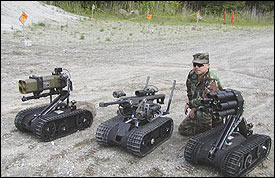Will U.S. soldiers be replaced by robots in Iraq?

The Pentagon may have found an imaginative solution to drastically reduce the number of U.S. soldiers killed in "preventive wars."
Some 1,678 U.S. military personnel have been killed in Iraq and Afghanistan since July of 2003, according to the Georgia based Iraq Coalition Casualty Count, but the count would have been much higher without the help of some 5,000 IED detecting robots.
In view of the unpopularity of the war in the U.S. and around the world, the next step--short of a traditional withdrawal--might be the evolution of those robots from saving to taking lives.
The U.S. Army soon plans to deploy armed robots with firepower into the wars in Iraq and Afghanistan. Designed by Foster-Miller, robots of this sort, known as SWORDS (Special Weapons Observation Reconnaissance Detections Systems) might soon begin replacing soldiers: they would be operated and fired by remote control and outfitted with M240 or M249 machine guns or Barrett .50 caliber rifles.
SWORDS first came to light in 2005, when the Associated Press reported, “Military officials like to compare the roughly three-foot-high robots favorably to human soldiers: They don’t need to be trained, fed or clothed. They can be boxed up and warehoused between wars. They never complain. And there are no letters to write home if they meet their demise in battle.”
Swords are not alone in the market. On Oct. 21, 2007 CBS reported that iRobot, founded in 1990 by MIT roboticists, and one of several robotic companies contracting with the military, would be ready to launch its iRobot’s Warrior in Iraq by 2009. Warrior, like SWORDS, is currently being designed to have human operators, but why not have the robots "think for themselves?"
In that case any "collateral damage," now attributed to human "error," would be the robot's fault and that would certainly have clear political implications. The public mood is a necessary conditioning factor for carrying on wars.
Oh. The U.S. budget for research and development for military technology is around $71 billion, although only a fraction of the hefty $500 billion U.S. defense budget. According to DefenseLink, the Pentagon plans to spend $2 billion on robots.
This may not mean robots will be taking over the task of the Pentagon's soldiers. However, it does imply another step in the "privatization" of conflicts and an attempt to make them more acceptable to the U.S. taxpayer. Seeing soldiers brought home wrapped in flags is a politically explosive issue. Who would bother to protest the death of a robot?
0 comentarios